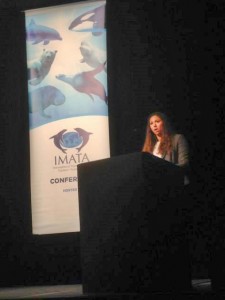US Virgin Islands Hotel & Tourism Association
 Coral World is pleased to announce that the International Marine Animal Trainer’s Association (IMATA) annual conference on Oct. 2 was the venue for a presentation by Madeleine Arencibia concerning the results of her research project with Coral World’s sea lions. The research was carried out as part of her studies at the University of the Virgin Islands. Madeleine is a candidate for a Master’s degree at UVI and elected to pursue her graduate studies at Coral World because of her special interest in the work with pinnipeds belonging to her advisor, Dr. Paul Jobsis. Pinnipeds are marine mammals that have both front and rear flippers and include, sea lions, seals and walruses.
Coral World is pleased to announce that the International Marine Animal Trainer’s Association (IMATA) annual conference on Oct. 2 was the venue for a presentation by Madeleine Arencibia concerning the results of her research project with Coral World’s sea lions. The research was carried out as part of her studies at the University of the Virgin Islands. Madeleine is a candidate for a Master’s degree at UVI and elected to pursue her graduate studies at Coral World because of her special interest in the work with pinnipeds belonging to her advisor, Dr. Paul Jobsis. Pinnipeds are marine mammals that have both front and rear flippers and include, sea lions, seals and walruses.
Lee Kellar, General Curator of Coral World, said she is “very pleased that we have developed a collaborative relationship with UVI that benefits students and results in useful data for the care of our animals.”
According to Madeleine, “Before deciding to come to UVI, I spoke with Dr. Jobsis about what opportunities there were for marine mammal research in the Virgin Islands because there are no longer any resident pinnipeds in the area. Dr. Jobsis informed me about the work he had started a year earlier with the sea lions at Coral World.”
The work being done by Dr. Jobsis with Coral World’s sea lions created a unique opportunity for Madeleine as the only student in the Master’s program who would be working with marine mammals and one of the few students working with Dr. Jobsis.
Madeleine described her project as seeking to gain insight into two aspects of male South American sea lion physiology- metabolic rate and the aerobic dive limit. She noted, “The metabolic rate was important information by itself to support optimal care for the sea lions at Coral World. The metabolic rate helps us to determine how much energy the sea lions are using and consequently how much they need to eat.” According to Madeleine, the work regarding aerobic dive limit has never been conducted on male South American sea lions before.
The aerobic dive limit or ADL measures how long a marine mammal can dive while using only their oxygen stores. The ADL is determined by combining the metabolic rate data with data on how much oxygen the sea lions can physically store in their body.
Madeleine stated, “When we compared our information about the Coral World sea lions to other species of otariids (which include sea lions and fur seals), we found that the boys at Coral World do not differ significantly from these other species of sea lions.”
While the study was limited because there were only two subjects available, it is important because such a study has never been conducted on male South American sea lions before.
Madeleine concluded, “The ADL can be applied to studies of dive behaviors in the wild and can help determine if wild populations are acting normally or if their behaviors are being affected by human activity such as over-fishing that could result in changes in prey behavior or increased pollution that could make foraging more difficult. So the data from my research is helpful for both providing the best human care to the Coral World sea lions and for protecting their wild counterparts.” Madeleine will be defending her thesis in less than a month’s time.
Kellar observed that there will be more opportunities for research with marine mammals when Coral World’s dolphin program is operational.
For more information, contact Lee Kellar at lkellar@coralworldvi.com or 340-775-1555 ext. 222.
